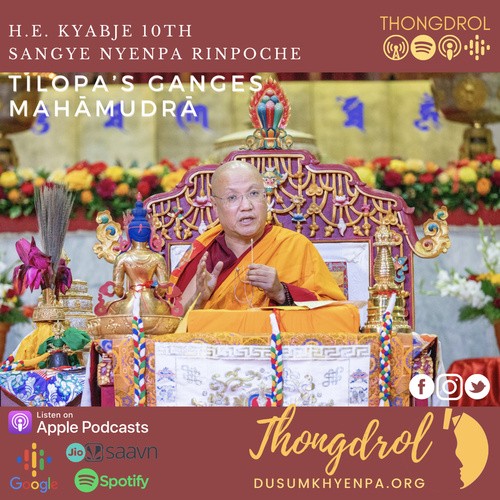
Tilopa’s Ganges Mahāmudrā Ep 5 (TIBETAN) Sangye Nyenpa Rinpoche
Episode · 0 Play
Episode · 3:11:15 · Nov 17, 2020
About
Reminding everyone to hold bodhichitta in their hearts, Kyabje  Drubwang Sangye Nyenpa Rinpoche began his third and last day of teaching  Tilopa’s Ganges Mahamudra, the upadesha or key instructions for the  practice of mahamudra. At the start of his talk, Nyenpa Rinpoche  reviewed the previous verses and added new commentary. He explained that  highly developed adepts could realize the whole text by simply hearing  the title. Summarizing the text’s meaning at the next level comes in the  traditional prostration of the translator: I prostrate to the glorious Vajra Dakini. Here, “dakini” refers to the entire meaning of the verses: the nature  that is the ground of mahamudra and the nature that is the path of  mahamudra; when these two manifest, the fruition of mahamudra appears.  In this way the dakini symbolizes the realization of ground, path, and  fruition. According to the teachings of the Kalachakra, “dakini” points  to Prajnaparamita, the great mother of all the buddhas. Another way to express this is that no phenomenon transcends the  fundamental nature. When the great mother Prajnaparamita manifests, we  can see the true nature of all phenomena appearing as samsara and  nirvana. Female deities, such as Tara and Vajra Varahi, are displays of  the great mother’s form. Here the vajra symbolizes the mahamudra of the  definitive meaning, which is represented here as the glorious Vajra  Dakini. The Student and Teacher The first verse of the Ganges Mahamudra describes students who could  practice mahamudra and they have four characteristics. (1) Intelligence  is the most important as it allows one (2) to endure hardship, (3) to  see the qualities of the guru and therefore have respect, and (4) to  bear the suffering that comes with practice, as we engage our body,  speech, and mind fully in listening, reflecting, and meditating on the  teachings. How we act depends on the conditions around us, and our  intelligence allows us to know what makes a condition positive or  negative. This is not a mere intellectual knowing but based in the  experience of practice. Since Naropa had all four of these qualities, Tilopa gave him all the  pith instructions on the banks of the Ganges, saying to his disciple,  “I have no human guru. In coming to your own realization, you’ll realize  the guru.” Today we can meet teachers and discuss the Dharma with them for  hours. But this might not be the good fortune we take it to be if we do  not develop the power and strength of our meditation. We should be able  to go through difficulties. Meeting the Dharma is not like finding gold  by chance. It comes from gathering the two accumulations and from karmic  connections that extend back for many generations. If we are  constructing a tall building, we need a stable foundation. To meet a  real guru we need genuine conviction.
3h 11m 15s · Nov 17, 2020
© 2020 Podcaster